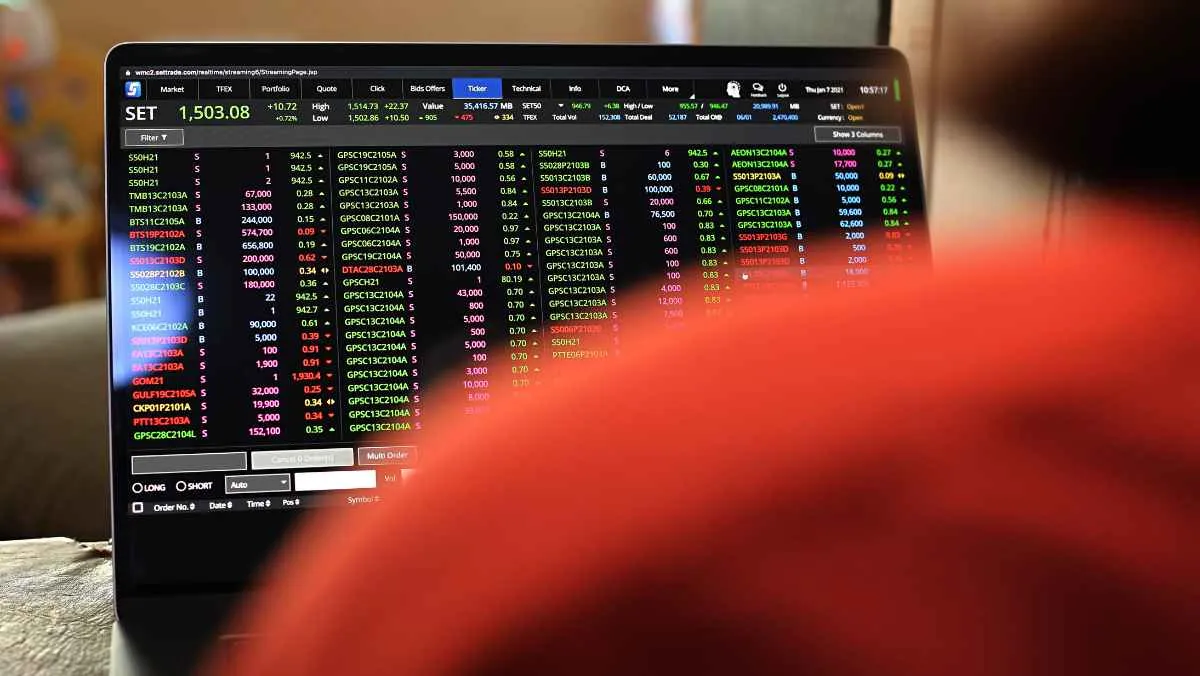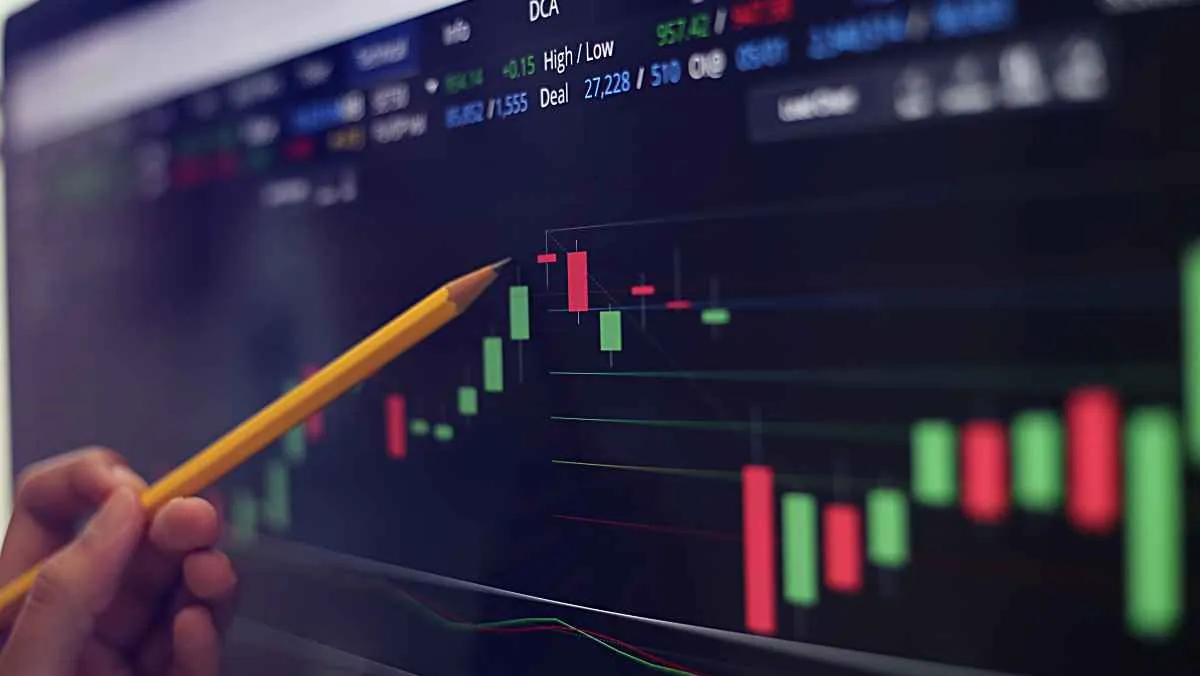Wednesday Dec 6 2023 06:31

11 min

The exponentially weighted moving average (EWMA) is a type of moving average that places greater weight and significance on the most recent data points. Many traders prefer the EWMA over the simple moving average (SMA) as it reflects the latest price activity more closely.
In this article, find out how we figure out EWMA, see how it helps us in trading, and learn about its pros and cons.
The exponential weighted moving average calculation uses a smoothing factor commonly represented by the Greek symbol alpha (α). The alpha sets how quickly older price data decays to less importance, with higher alpha discounts making the EWMA more responsive to recent changes.
Here is the formula for calculating an exponential weighted moving average:
EWMA = (Closing Price x Smoothing Factor) + (Previous EWMA x (1 - Smoothing Factor))
To break this EWMA formula down:
The smoothing factor chosen depends on your trading style and time frame. Shorter-term traders tend to use higher smoothing factors. Longer-term investors use lower smoothing factors for a slower-moving average.
Below is a step-by-step example of calculating an exponential weighted moving average:
Recent closing prices: $56, $53, $58, $62 (with oldest at the beginning)
Chosen alpha smoothing factor: 0.4
This example shows how each new closing price impacts the EWMA result less and less as the previous data is accounted for via that (1 - alpha factor) element. The older data points exponentially decay in relevancy but still slightly influence the current EWMA value.
Traders will repeat this exponential weighted moving average calculation for each new closing period, either daily, hourly, etc. Using the EWMA in analysis and trading strategies can help spot trend reversals earlier than less responsive simple or traditional moving averages. The versatility and adaptability of the exponential weighted moving average make it a popular technical indicator with traders in many markets.
Here’s an interesting read for you: What Is A Commodity Profit Calculator?
The exponentially weighted moving average is popular amongst traders for identifying trends, planning entries and exits, and combining it with other strategy analysis methods. Its ability to smooth data and quickly respond to recent price moves makes it uniquely valuable.
One of the most common uses for the exponential weighted moving average is in trend-following and breakout strategies. Traders will look for the price to trade above or below the EWMA to signal the start of a new trend.
As the EWMA reacts faster than less adaptive moving averages, it can quickly identify the start of short-term and intraday trends. Traders can go long when the price breaks above the EWMA and exit when it crosses below it, or a stop loss is hit. For downtrends, traders sell short when the price drops below the EWMA line and close the position when the price breaks above.
While good for spotting trends early, the responsive nature of the exponentially weighted moving average also makes it useful for mean reversion strategies. Its frequent adjustments create opportunities where the price diverges too far from the average and is expected to revert.
Traders applying a mean reversion approach would buy when the price drops significantly below the EWMA, expecting it to bounce back towards the average. They go short when the price rises substantially above the line, anticipating a pullback toward the mean. Exits occur when the price reaches back to the EWMA level.

For the EWMA to work in mean reversion setups, the alpha must be tuned to reflect the normal trading range rather than larger long-term trends. Using traditional technical analysis with the EWMA, such as overbought/oversold levels, can improve signal accuracy.
While useful for basic trend and counter-trend strategies, traders often combine the exponentially weighted moving average with other technical indicators for confirmation. Oscillators that measure momentum, like the Relative Strength Index (RSI) or Stochastic Oscillator, can be used to identify oversold/overbought levels and improve entry and exit timing.
Moving average crossovers are also popular, with traders buying or selling when a short-term EWMA crosses a longer one. Adding volume confirmation ensures breakouts have strong conviction before acting. Using the EWMA with other well-known indicators can significantly increase strategy performance.
Consider giving this a look: What Is A Trading Indicator And How It Helps You As A Trader
The exponentially weighted moving average has some excellent advantages over other types of moving averages, especially when it comes to smoothing price data and reacting quickly to recent price changes. However, the EWMA still has some disadvantages to consider before incorporating it into trading strategies.
A significant advantage of the EWMA is its ability to smooth out the noise and volatility of price data that is mostly meaningless to the underlying trend. The EWMA formula filters out fleeting price movements unrelated to sustained momentum by applying greater emphasis on the most recent closing prices.
This makes it easier for traders to analyse the dominant trend direction and forecast where prices may head next.
Short-term fluctuations and spikes can mask the authentic trend and trigger premature buy and sell signals without smoothing effects. This tends to result in losses from acting on false signals and unnecessary bid-ask spread costs from excessive trading. By damping insignificant noise, the exponentially weighted average helps traders patiently ride out minor retracements within trends and avoid chasing every minor price bounce.
EWMA stands out with its quick reactions to the most recent price shifts. As previous closing prices have exponentially less relevance to the current EWMA value, traders don’t have to wait long for the indicator to reflect ups and downs.
This allows traders to spot emerging trend reversals at earlier stages.
Rather than lagging too far behind like less adaptive traditional moving averages, the EWMA’s formula enables fast-moving averages. Getting quicker signals means identifying breakouts and pullbacks sooner, allowing earlier entries.
Finding new trends as they emerge helps capitalise on more of the price movement rather than fewer period gains. Over time, faster signalling can significantly improve profitability.

Despite reacting quicker than other moving averages, the exponential weighted moving average still relies on historical price data in its formula. Looking backwards rather than forwards means there will always be some degree of lag against current prices. No past data can perfectly predict future prices.
So, when price volatility expands, the lag effect may also increase. This can result in late signals at major turning points, potentially entering after a substantial share of the new trend’s price movement has developed.
Getting delayed signals heightens the odds of buying near short-term tops and selling closer to lows. Patience is critical until confirmation signals emerge when using the lagging EWMA.
Traders must take care when selecting an appropriate alpha smoothing factor. Low alpha settings slow the EWMA response time, while levels set too high increase noise sensitivity and volatility in the calculated moving average. Failing to fine-tune alpha for your strategy’s timeframe may hinder success.
Blindly applying general alpha setting rules rarely optimises EWMA effectiveness. Each trader must evaluate various smoothing factors through trial and error and backtesting. Checking what alpha levels boosted strategy profitability historically guides the best settings to apply going forward. Without custom tuning, the exponentially weighted moving average may not reach its full potential.
The exponential weighted moving average (EWMA) is a unique type of moving average that applies greater significance to the most recent price data. This weighting causes it to react faster to price changes than standard moving averages. The EWMA formula enables smoothing noisy price data to reveal trends while staying responsive to emerging shifts.
While the concepts may seem complex at first glance, the exponentially weighted moving average can be invaluable for traders of all skill levels. Its ability for faster signalling and noise reduction can improve strategy timing and performance. Just be sure to take time to find the proper smoothing factor alpha for your preferred trade timeframes.
Improve your trading skills by trying out the EWMA indicator. It helps make your strategies more precise and timely. Add it to your past chart analysis and testing to make it work better. Adjust the alpha smoothing factor to get the most out of the Exponential Weighted Moving Average.
Give it a shot with our free demo account made just for you. Practice making trades using EWMA signals and build confidence in your abilities. With virtual money, you can trade without worries and get better at what you do!
Ready to trade with markets.com? Creating an account is easy!
“When considering “CFDs” for trading and price predictions, remember that trading CFDs involves a significant risk and could result in capital loss. Past performance is not indicative of any future results. This information is provided for informative purposes only and should not be considered investment advice.”